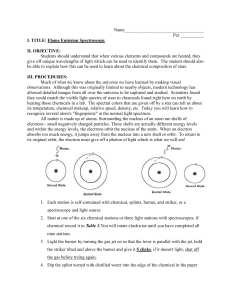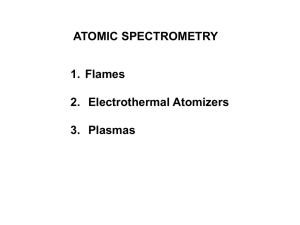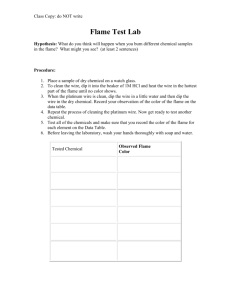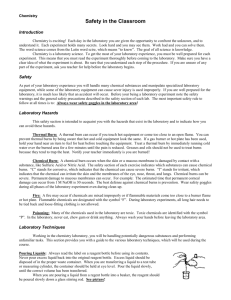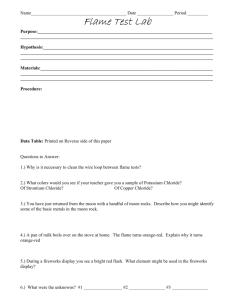Name - Beachwood City Schools
advertisement
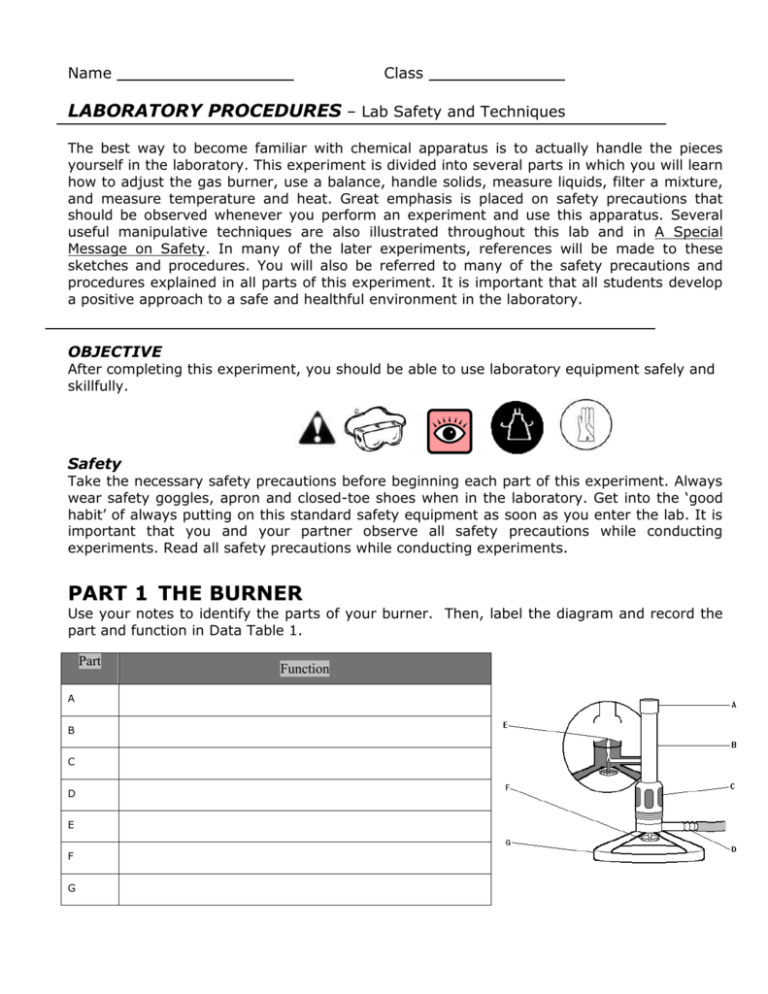
Name Class LABORATORY PROCEDURES – Lab Safety and Techniques The best way to become familiar with chemical apparatus is to actually handle the pieces yourself in the laboratory. This experiment is divided into several parts in which you will learn how to adjust the gas burner, use a balance, handle solids, measure liquids, filter a mixture, and measure temperature and heat. Great emphasis is placed on safety precautions that should be observed whenever you perform an experiment and use this apparatus. Several useful manipulative techniques are also illustrated throughout this lab and in A Special Message on Safety. In many of the later experiments, references will be made to these sketches and procedures. You will also be referred to many of the safety precautions and procedures explained in all parts of this experiment. It is important that all students develop a positive approach to a safe and healthful environment in the laboratory. OBJECTIVE After completing this experiment, you should be able to use laboratory equipment safely and skillfully. Safety Take the necessary safety precautions before beginning each part of this experiment. Always wear safety goggles, apron and closed-toe shoes when in the laboratory. Get into the ‘good habit’ of always putting on this standard safety equipment as soon as you enter the lab. It is important that you and your partner observe all safety precautions while conducting experiments. Read all safety precautions while conducting experiments. PART 1 THE BURNER Use your notes to identify the parts of your burner. Then, label the diagram and record the part and function in Data Table 1. Part A B C D E F G Function Gather apparatus and materials: Apparatus Heat Resistant Mat Crucible tongs Burner Matches Evaporating dish Materials Copper wire, 18 gauge 1 Safety pin 2 wooden splints Procedures 1. The Bunsen or Tirrell burner is commonly used as a source of heat in the laboratory. Although the details of construction vary among burners, each has a gas inlet located in the base, a vertical tube or barrel in which the gas is mixed with air, and adjustable opening or ports in the base of the barrel. These ports admit air to the gas stream. The burner may have an adjustable needle valve to regulate the flow of gas. In some models the gas flow is regulated simply by the flow of gas. The burner is always turned off at the gas valve on the supply line, never at the needle valve. Look at Figure 1-1 as you examine your Bunsen burner and locate these parts. Figure 1-1 CAUTION Before you light the burner, check to see that you and your partner have taken the following safety precautions against fires: Wear safety goggles, and aprons. Confine long hair and loose clothing: Tie long hair back at the back of the head away from the front of the face, roll up long sleeves on shirts, blouses and sweaters away from the wrists. You should also know the locations of fire extinguishers, fire blanket, safety showers, and sand buckets and how to use them in case of a fire. 2. In lighting the burner, partially close the ports at the base of the barrel, light the match. Hold the lit match just below the top of the barrel. Turn the gas full on and slowly raise the lit match toward the top of the barrel. The gas flow may be regulated by adjusting the gas valve until the flame has the desired height. If a very low flame is needed, remember that the ports should be partially closed when the gas pressure is reduced. Otherwise, the flame may burn inside the base of the barrel. When improperly burning in this way, the barrel will get very hot, and the flame will produce a poisonous gas, carbon monoxide. CAUTION Carbon monoxide is a poisonous gas. If the flame is burning inside the base of the barrel, immediately turn off the gas at the gas valve. Do not touch the barrel of the burner, for it is extremely hot! Allow the barrel of the burner to cool off and then proceed as follows: Begin again, but first decrease the amount of air admitted to the burner by partly closing the ports. Turns the gas full on and then relight the burner. Control the height of the flame by adjusting the gas valve. By taking these steps, you should acquire a flame that is burning safely and is easily regulated throughout the experiment. 3. Once you have a flame that is burning safely and steadily, you can experiment by completely closing the holes (ports) at the base of the burner. Describe what the flame looks like when the ports are completely closed. 4. Using the crucible tongs, carefully hold an evaporating dish in the tip of the flame (underside to the flame) for about 3 – 5 minutes. Place the dish on the ceramic pad, allow the dish to cool, and then examine the underside. Describe the results and suggest a possible explanation for this observation. Such a flame is seldom used in the laboratory. For laboratory work, you should adjust the burner so that the flame will be free of yellow color, nonluminous, and also free from the ‘roaring’ sound caused by admitted too much air. 5. With low amounts of oxygen, the flame is relatively cool and is referred to as a luminous yellow flame. As more oxygen is mixed with the gas, the temperature of the flame increases. A very hot flame is referred to as nonluminous and is characterized by a blue cone surrounded by a larger yellowish envelope. In a flame with three zones the flame temperature varies from region to region. In the relatively hot flame methane undergoes complete combustion (or oxidation) forming only the expected products, carbon dioxide and water; there are no carbon particles so the flame is nonluminous. 6. Explore the nature and temperature of different parts of the burner flame by holding a wood splint in the center of the flame at each of the following positions: You should only scorch the wood splint, do not allow it to burn and hide the original scorch pattern. Use a fresh portion of the wood splint or a different splint at each flame position. Record your observations for each location. (1) resting on the top of the barrel _______________________________________________ (2) below the tip or top of the inner cone __________________________________ (3) just above the tip of the inner cone ___________________________________ (4) just above the top of the outer cone __________________________________ 7. Taping the scorched portion of the wood splint onto the lab 8. Check your observations by holding a piece of copper wire (with forceps) horizontally in the center of the flame with one edge of the gauze resting on the barrel top. To do this, regulate the flow of gas to give a flame extending roughly 8cm above the barrel. Now adjust the supply of air until you have a quiet, steady flame with a sharply defined, light blue inner cone. This adjustment gives the highest temperature possible with your burner. Using the crucible tongs, inset a 10-cm piece of copper wire into the flame just above the barrel. Lift the wire slowly up through the flame. Where is the hottest portion of the flame located? 9. Hold the wire in this part of the flame for a few seconds. Observe both the flame and the wire. Describe the results of each. 10.Shut off the gas burner. Now think about what you have just observed in the proceeding procedures. Why is the nonluminous flame preferred over a yellow luminous flame in the laboratory? 11.Record the position of the hottest portion of the flame. _____________________________________________________________________ 12.Push a straight pin through a wooden or paper match just below the head of the match. 13.Place the pin on the top of the burner barrel so that the match head is centered in the barrel just above the barrel top and the rest of the match hangs down inside the barrel. 14.It may be difficult, but turn the gas on full and light the burner. 15.Record what happens to the match. _________________________________________________ 16.Speculate on the composition and temperature of the lowest or colorless cone of the burner flame. _____________________________________________________________________ _____________________________________________________________________ _________________ 17. Draw a picture of the flame and indicate what part is the hottest. 18. In conclusion, I learned…. 19. If I had the opportunity to do this lab again, I would…. 20.At the end of this part of the experiment, all equipment you store in the lab drawer should be completely cool, clean, and dry. It should also be arranged in an orderly fashion for the next lab experiment. Check to see that the valve on the gas is completely shut off. Remember that hands should always be washed thoroughly with soap at the conclusion of each laboratory period. PART 2 HANDLING SOLIDS Apparatus Test Tube Weigh paper Spoon Materials Magnesium Sulfate MgSO4 Safety warning: irritant to eyes and respiratory track CAUTION Do not touch chemicals with you hands. Some chemical reagents readily pass through the skin barrier into the bloodstream and can cause serious health problems. Some chemicals are extremely corrosive. Always wear gloves, apron, and safety goggles when handling chemicals. Carefully check the label on the reagent bottle or container before removing any of the contents. Never use more of a chemical than directed. You should also know the locations of the lab shower and eyewash and how to use them in case of an accident. CAUTION Never try to pour a solid from a bottle into a test tube. Never try to put chemicals into a test tube with a spoon. The chemicals could miss and touch your hands, or you would need to clean them up of the table. As a precaution against contamination, never pour unused chemicals back into the reagent bottles. CAUTION Never discard broken glassware into the wastepaper basket. This is an important safety precaution, and it prevents personal injuries to anyone who empties the wastepaper basket. Never discard chemicals in the wastepaper basket unless told by your teacher to do so. This is an important safety precaution against fires and toxic waste being disposed of inappropriately. Figure 1-3 1. Solids are usually kept in wide-mouthed bottles. A porcelain or plastic spoon should be used to dip out the solid. See figure 1-3. 2. Remove a small spoonful of magnesium sulfate from its reagent bottle. In order to transfer the magnesium sulfate to a test tube, first place it on a piece of weigh paper about 10 cm square. Roll the paper into a cylinder and slide it into a test tube that is lying flat on the table. When you lift the tube to a vertical position and tap the paper gently, the solid will slide down into the test tube. See Figure 1-4. 3. Give two reasons why it is important to use this method of transferring solids into a test tube. 4. Throw the magnesium sulfate into the waste container provided by your teacher. Throw the waste paper into the wastepaper basket. 5. Remember to clean up the lab and wash your hands thoroughly at the end of this part of the experiment. PART 3 THE BALANCE Part A. Proper use of the Centigram balance Apparatus Centigram balance Weigh paper Spoon Materials Magnesium Sulfate MgSO4 Safety warning: irritant to eyes and respiratory track Procedures 1. When a balance is required for determining mass, you will use a centigram balance. See Figure 1-5. The centigram balance is sensitive to 0.01 gram. This means that all your mass readings should be recorded to the nearest 0.01 gram. Figure 1-5 2. The balance should only be moved by grasping under the carriage base center support, and gently lifting it off of the table. NEVER grab the balance by the beams. 3. Before using the balance, always check to see if the pointer is resting at zero. If the pointer is not at zero, check the slider weights. If all the slider weights are at zero, turn the zero adjust knob until the pointer rests at zero. The zero adjust knob is usually located at the far left end of the balance beam. Whenever weighing chemicals, always use weighing paper or a glass container NEVER place chemicals or hot objects directly on the balance pan. They can permanently damage the surface of the balance pan and affect the mass weighing. CAUTION Do not touch chemicals with you hands. Always wear safety goggles and apron when handling chemicals. Carefully check the label on the reagent bottle or container before removing any of the contents. Never use more of a chemical than directed. You should know the locations of the safety shower and eyewash and how to use them in case of an accident. Never place hot glass or chemicals in your lab drawer as this could cause a fire. 4. Make sure that the pointer on the balance is set at zero by following procedure 3. Once your balance is zeroed, have the teacher initial the block below before proceeding to the next step. 5. Obtain a piece of weigh paper (in the fume hood) and place it on the balance pan. Determine the mass of the paper by adjusting the weights on the various scales. Record the mass of the weigh paper to the nearest 0.01g. Again, have the teacher initial your reading. 6. Add 13.00 grams to the balance by sliding over the weight of the 10-gram scale to 10, and the weight of the 1-gram scale to 3. 7. Using a spoon, obtain a quantity of magnesium sulfate from a reagent bottle and place it on a separate piece of weigh paper. 8. Now slowly pour the magnesium sulfate from the weigh paper onto the weigh paper in the balance pan, until the pointer once again comes to zero. 9. Record the mass of the weigh paper and magnesium sulfate to the nearest 0.01g. 10.Calculate the mass of the magnesium sulfate you have measure out. 11.Place the magnesium sulfate into the labeled waste container provided by your teacher. All weigh paper should be thrown into the regular garbage cans. CAUTION Never discard chemical or broken glassware into the wastepaper basket. This is an important safety precaution against fires, and it prevents personal injuries to anyone who empties the wastepaper basket. As a precaution against contamination, never pour unused chemicals back into their original bottles. Part B. Proper use of an electronic scale Sometimes you will have access to an electronic scale. You can weigh chemicals simply by first placing the a weighing paper or weighing boat that will hold the chemical on the scale and pressing zero. This is called taring the scale. Then, add your chemical to the vessel and record the weight. You may also record the mass of the empty weighing boat and then weigh the weighing boat and chemical and subtract the two masses to obtain the mass of the chemical. Apparatus Electronic scale Weighing boat (small plastic cup) Spoon Materials Sodium Chloride, NaCL (table salt) Safety warning: Very slightly toxic by ingestion. Dust may cause minor irritation to mucous membranes upon inhalation Procedure: 1. Turn balance on by pressing on button 2. When you see all zeros you are ready to begin 3. You will mass out things using either weighing paper or weighing boat 4. Mass out a small amount of NaCL a. Place the weighing boat on the scale then hit zero, which is a tar, this way you don’t have to remember how much the boat weights Place a small amount (about ¼ teaspoon) of NaCL in the boat and record your mass to the third decimal place. Note, fluctuations in the thousandth decimal place are typical. Your mass_______________________ b. Repeat the procedure so that your partner has a turn. And, record the mass. partner’s mass _________________ PART 4 Figure 1-13 FILTRATION and evaporation Apparatus Ring stand stirring rod Ceramic-centered Wire gauze Evaporating dish Matches Burner Wash Bottle Filter paper Iron ring Funnel Materials Sodium Chloride, NaCL, table salt Water Fine Sand Procedures 1. Sometimes liquids contain particle of insoluble solids, present either as impurities or as precipitate formed by the interaction of the chemicals used in an experiment. If the particles are insoluble and denser that water, they soon sink to the bottom. Most of the clear, supernatant (swimming above) liquid may be poured off without disturbing the precipitate. Such a method of separation is known as decantation. The soluble salts are in the supernatant liquid which has been decanted. Figure 1-12 2. Fine particle, or particles that settle slowly, are often separated from a liquid by filtration. Support a funnel on a small ring on the ring stand as shown on Figure 1-12. If the ring is too large place a clay triangle on top of the ring to support the funnel Use a beaker to collect the filtrate. Adjust the funnel so that the stem of the funnel just touches the inside wall of the beaker. This will speed up the filtration process by decreasing the dropping, hence increases the continuous flow through capillary action due to the intermolecular force, hydrogen bonding. 3. Fold a circular piece of filter paper along its diameter, and then fold it again to form a quadrant. See Figure 1-13. Separate the folds of the filter, with three thicknesses on one side and one on the other; then place it into the funnel. The funnel should be wet before the paper is added. Use your plastic wash bottle to do this. Then wet the filter paper with a little water and press the edges firmly against the sides of the funnel so no air can get between the funnel and the filter paper while the liquid is being filtered. 4. EXCEPTION: A filter should not be wet with water when the liquid to be filtered does not mix with water. WHY? _______________________________ 5. Dissolve between 2 and 3 grams of sodium chloride, and mix 2 to 3 grams of fine sand into a beaker containing about 50ml of distilled water. Then filter out the sand by pouring the mixture into the filter, observing the following suggestions: a) The filter paper should not extend above the edge of the funnel. It is better to use a filter disc that leaves about 1cm of the funnel exposed. b) Do not fill the filter. It must never overflow. The liquid must never go above the paper line. c) Try to establish a water column in the stem of the funnel thus excluding air bubbles, look at # 2, and then add the liquid just fast enough to keep the level about 1cm from the top of the filter paper. d) When a liquid is poured from a beaker or other container, it may adhere to the glass and run down the outside wall. This may be avoided by holding a glass stirring rod against the lip of the beaker, as shown in Figure 1-12 on the previous page. The liquid will run down the rod and drop off into the funnel without running down the side of the beaker. e) To remove the remaining sand from the beaker. Hole the beaker with its spout down towards the funnel and squirt your wash bottle up into the beaker to wash out the sand product. This is a useful skill. The sand is retained on the filter paper. What PROPERTY of the sand enables it to be separate from the water by filtration? What does the filtrate contain? Figure 1-14 6. The salt may be recovered from the filtrate by pouring the filtrate into an evaporating dish and evaporating it nearly to dryness. See Figure 1-14 for the correct setup. 7. Turn back the flame as soon as the liquid begins to spatter. What PROPERTY of salt prevents it from being separated from the water by filtration? 8. At the end of this part of the experiment, all equipment you store in the lab drawer should be completely cool, clean, dry, and arranged in an orderly fashion for the next lab experiment. 9. Check to see that the valve on the gas jet is completely turned off. Make certain that filter papers and sand are thrown into the waste jar or container provided by your teacher and NOT down the sink. Wash your hand thoroughly before leaving the lab. SAFETY CHECK Identify the following safety symbols: TRUE or FALSE Read the following statements and indicate whether they are true or false. Place your answer in the space next to the statement. 1. Never work alone in the laboratory. 1. 2. Never lay the stopper of a reagent bottle on the lab table. 2. 3. At the end of an experiment, save all excess chemical and pour them back into their stock bottles. 3. 4. The quickest and safest way to heat a material is a test tube is by concentrating the flame on the bottom of the test tube. 4. 5. Use care in selecting glassware for high temperature heating. Glassware should be Pyrex or a similar heat-treated type. 5. 6. A mortar and pestle should be used for grinding only one substance at a time. 6. 7. Safety goggles protect your eyes from particle and chemical injuries. I do not need to make my teacher aware of the fact that I wear contact lenses. 7. 8. Never use the wastepaper basket for disposal of chemicals unless told to do so by your teacher. 8. 9. First aid kits may be used by anyone to give emergency treatment after and accident. 9. CHEMICAL APPARATUS Identify each piece of apparatus. Place your answers in the cell with the picture in it.
